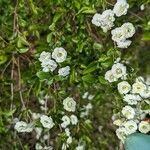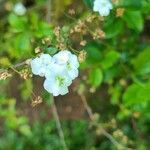Shrubs, 10–30 dm. Stems erect, ?virgate?, branched. Leaves: petiole 1–4 mm, ?pubescent?; blade usually ovate to elliptic, sometimes oblanceolate, 1–4(–5) × 1–2 cm, membranous, base obtuse, margins serrulate, usually from near base to apex, sometimes only distally from middle, rarely nearly entire with few teeth apically, venation pinnate cladodromous, secondary veins not prominent, apex acute to obtuse, abaxial surface lanate to glabrescent, adaxial glabrate. Inflorescences mostly axillary, usually hemispheric panicles, sometimes simple fascicles, ?3–6-flowered, sessile?, 2–3 × 1–3 cm; ?bractlets 3–7 × 3–5 mm?; branches pubescent. Pedicels 10–30 mm, pubescent. Flowers 5–15 mm diam.; hypanthia campanulate, 1–1.2 mm, abaxial surface glabrous or sparsely hairy, adaxial glabrous; sepals ovate to ovate-triangular, 1–3 mm; petals white to cream, ?often with more than a single whorl of petals in most commonly escaped form?, ovate to obovate, 2–10 mm; staminodes 10–16, ?irregularly fused?; stamens 20–25, 0.5 times petal length. Follicles oblanceoloid, 1.5–2 mm, glabrous, ?adaxial suture sparsely hairy?. 2n = 18.
Shrub 2-3 m; lvs ovate or ovate-oblong, short-petioled, 2-4 cm, finely serrulate; umbels axillary, sessile or nearly so, with 3-6 white, commonly double fls 8-10 mm wide on pubescent pedicels 1-2 cm. Native of e. Asia, often escaped in our range. May. Two other cult. spp. and one hybrid that would key to S. prunifolia occasionally escape. S. thunbergii Siebold has lance-linear, sparsely serrate lvs and sessile or subsessile umbels with 3-6 fls on glabrous pedicels 1-1.5 cm. S. chamaedryfolia L. has ovate or ovate-oblong lvs with numerous sharp teeth, and peduncled dense corymbs of fls with exserted stamens, terminating leafy branches. S. ×vanhouttei (Briot) Zabel, the Bridal wreath, has rhombic-ovate to obovate lvs few-toothed above, and peduncled corymbs of fls with short stamens, terminating short leafy branches.
A small shrub or rounded bush. It grows 2 m high and spreads 2 m wide. It loses its leaves during the year. The leaves are egg shaped and have very small teeth. The leaves turn reddish-orange in autumn. The flowers are white and double. They are in clusters.


